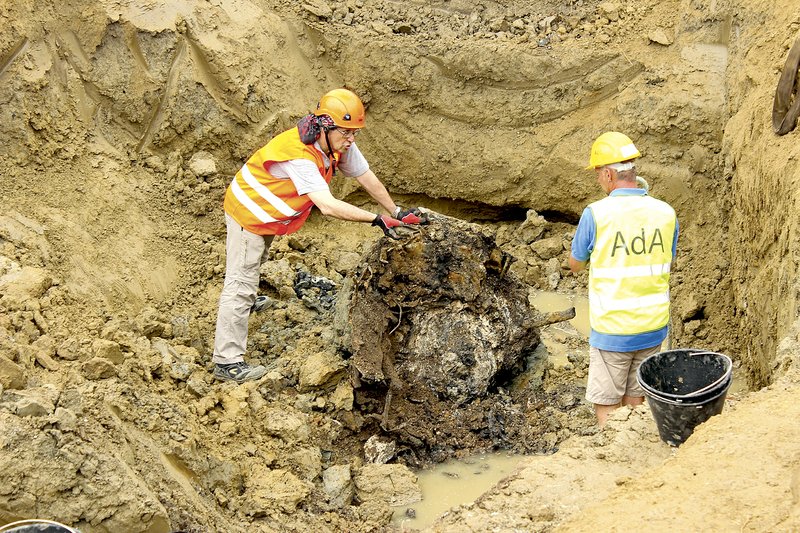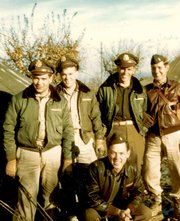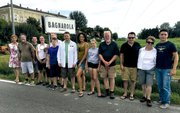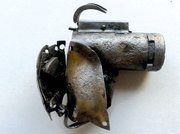Loren Hintz volunteered for a mission that was supposed to help him get home more quickly to his wife, Gert, his young daughter, Gretchen, and an unborn son, Martin. Seventy-one years later, his family found him, thanks in large part to fellow searchers on the other side of the Atlantic.
"Holding those dog tags in the palm of my hand is the most physical connection with my grandfather I will ever have," said Hans Wronka of Duluth, Minn. Those dog tags were also the proof -- the plane the family and their Italian fellow-searchers had found near Bagnarola, Italy, was the right plane. No doubt about it.
That day came July 23. Family members from around the United States, including adult grandchildren from Bentonville, Fayetteville and Rogers, were there. Wronka and Daniel Hintz of Bentonville, also a grandson, insisted repeatedly in interviews that volunteers in Italy deserved as much credit for finding the plane as the aviator's descendants.
"You get goosebumps just standing in the place," Daniel Hintz said. "The thing you think of most is the sacrifice there was in that campaign. They were kids at the time this happened and came from all over the world to this spot. There were Maori tribesman from New Zealand in the 5th Army that my grandfather was supporting.
"You're thinking of this while looking at a house that's 600 years old, not too far from a bridge the Romans built, realizing that your grandfather is part of that history now. He was a writer, dancer and a poet, but also a farm kid from Iowa. He died in the field of another family's farm in Italy, not all that much different from the fields he came from. And that family sacrificed just like yours did. That family lost a grandfather that day, killed by artillery at about the same time."
"Moments like that are more than a little bit overwhelming. You realize, most of all, the lost potential."
First Lieutenant Loren E. Hintz, 27, of Charles City, Iowa, flew P-47s for the U.S. Army Air Corps. Those planes were a monster of an aircraft for its day. British Spitfires were so dainty by comparison, Royal Air Force fighter pilots joked that Yanks could leave their seats and run around inside a P-47 if German fire got too close. The barrel-shaped American single-seat fighter was pulled through the air by a huge 2,100-horsepower engine. Later models had even more power. The motor alone weighed more than a ton, and its 18 pistons were each wider than a half-gallon paint can. Two banks of nine cylinders each radiated around the motor's short center like an enormous steel and aluminum daisy.
Lt. Hintz flew for the 86th Fighter Squadron of the 79th Fighter Group. He was assigned an older model P-47 on April 21, 1945. He was flying low, a few hundred feet above the ground, while trying to take out German machine gun nests with gunfire and napalm. The young fighter pilot took the mission because he was trying to score "points." The Air Corps had invented the "Advanced Service Rating Score," in which people who had flown more combat missions got to go home first. Those who had fought longest and hardest should be first in line for their return home, as the Army put it. The war in Europe was ending. Those with high scores would not be transferred to the war in Pacific, a reshuffling that could cause a delay of weeks or months with no opportunity to score points.
By this time, European skies were almost clear of Axis aircraft, but there was plenty of demand for close air support of allied ground troops. The remaining German defenders were hard-bitten veterans. The Germans that Lt. Hintz strafed were covering the retreat as the rest rushed for the passes through the Alps into Germany for a last stand there. The strafed Germans fired back.
"We think it either had to be a one-in-a-million shot through the glass of his windshield and he died instantly, or something mechanical suddenly went very wrong," Daniel Hintz said. The recovered engine is being examined and might answer that question. Whatever happened, Loren Hintz' plane flew into the ground at about 400 miles an hour. That enormous Pratt & Whitney engine bored into a north Italian farm field like a meteorite, going about 18 feet deep. For seven decades, an Italian family wondered who lay buried in their field, his grave covered over by the charred remnants of the family's destroyed barn and covered up after months of waiting after the war. An American inspection crew had stopped by after the war's end and found Hintz' service pistol, collected a few artifacts to confirm Hintz' death and moved on without making a precise record of the location, Wronka said. Other families were waiting for definite word, too. The few remains found were interred in a U.S. Army cemetery in Florence, Italy.
The Hintz family might never have found the site if Loren Hintz' daughter had married a man named Thomas or Johnson, for instance. The Hintz family's most leading historian and searcher is her son, Hans Wronka, whose name is distinctive enough to be a huge help when Piero Fabbri of Bologna, Italy, went searching for him on the Internet four years ago.
Wronka, a geologist, lived in Alaska in 2000 when he did an Internet search for the 79th fighter group. There he found a web page and a message board used by group veterans to stay in touch. He left a message asking if anyone knew Loren E. Hintz, but received no replies. Wronka kept searching, though, compiling his grandfather's records from the Army. Meanwhile, that message sat for 12 years.
By sheer chance, Wronka was chatting with a business associate, John Hunt, years later in Montana in 2005. When they brought up a shared interest in World War II history, Hunt mentioned that his father-in-law was also a fighter pilot from that conflict. That father-in-law turned out to be a gentleman named Bob Johnson -- who not only knew Loren Hintz, but had been close friends with him since they met in pilot training together. They were both assigned to the 86th Squadron and served together until Hintz' death.
Wronka and members of the Hintz family met Johnson on Memorial Day 2006, when Johnson came to the home of Loren's widow. He visited with the family and talked to Mrs. Hintz of squadron life in Italy and flying P-47s.
"But even as the war was winding down, any chance he had, he was flying missions so he could get home. He was so determined to get home," Johnson said in an interview recorded by Wronka. Johnson died in February at the age of 94.
Years later, in 2012, Wronka received a message in broken English from a man he had never heard of -- Fabbri, a civilian pilot with a strong interest in aviation history. Fabbri's research led him to believe the pilot whose plane crashed somewhere near Bagnarola was Hintz. His search for Lt. Hintz led him to the message board for the 79th Fighter Group, or what was left of it.
"I don't even know how he found it," Wronka said. "The fighter group site itself didn't exist any more."
Daniel Hintz agreed that Fabbri's determination and resourcefulness led to the breakthrough. "Years of searching and 800 pages of documents, and the thing that led to us finding Loren was a random e-mail left on a message board, serendipity and a partnership with somebody we'd never met," he said. "This could not have happened without the Internet, without the ability for people the whole world over to find each other." Besides Fabbri, he also wanted to give credit to Marie Bonfini and Stefano Gherardi, two other volunteer searchers in Italy.
Wary at first of an internet scam, Wronka was tentative. But as the two men exchanged information, trust grew quickly. Fabbri had a list of pilots who had gone down in the area and was trying to resolve the fates of each one. In July 2012, Wronka went to meet Fabbri in Italy. The collaboration proved invaluable to both men. The fact that an American with a proven ancestry with the sought-for pilot increased the credibility of both.
"In Italy, family is everything," Wronka said. "When Fabbri could show people someone who was looking for a member of his family, that opened doors for us both." The most important single door opened was that of the Malvezzi family, a prominent local family with a history dating back to the Middle Ages.
Daniel Hintz agreed that the Italians were as devoted in the search as the American family. "I cannot express how grateful we are to all to the people in Italy," he said. "Without the Italian team, we most likely would never have been successful."
Those open doors led Wronka and Fabbri to local residents who identified three houses relatively close together as described by Lt. Hintz flightmates in after-action reports -- Hintz' plane's last known location. That led the searchers to a nearby field. And Fabbri flew his American guest by airplane along the same route Loren Hintz had flown all those years before. Everything fit.
But archeological digs are not light undertakings. The searchers needed a precise spot, not just the right field. Wronka's Italian fellow-searchers got the use of a electro-magnetometer. The device's scans found a large metallic object, which later proved to be the plane's engine. Meanwhile, Hintz family found more records. The amassed evidence convinced the Italian government to organize a dig. Family members made it to the site the day before the dig and were present the next morning.
The excavation quickly found Lt. Hintz' bone-handled knife, a personal possession. His flare gun soon followed. Remains were found, and his dog tags among burned bits and pieces of aircraft. And finally, up came the huge engine, largely intact, its carburetor wide open and serial numbers on it distinctly readable. The artifacts are now being studied in Italy and will hopefully answer more questions about Hintz' last moments. Lt. Hintz mortal remains were interred at his grave in Florence.
"The element of being overwhelmed never left," Daniel Hintz said.
NAN Our Town on 09/01/2016




